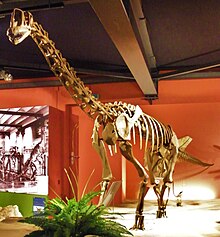Europasaurus
| Europasaurus | |
|---|---|

| |
| Reconstructed skeleton | |
| Scientific classification | |
| Domain: | Eukaryota |
| Kingdom: | Animalia |
| Phylum: | Chordata |
| Clade: | Dinosauria |
| Clade: | Saurischia |
| Clade: | †Sauropodomorpha |
| Clade: | †Sauropoda |
| Family: | †Brachiosauridae |
| Genus: | †Europasaurus Mateus et al. in Sander et al., 2006 |
| Species: | †E. holgeri
|
| Binomial name | |
| Europasaurus holgeri Mateus et al. in Sander et al., 2006
| |
Europasaurus is a basal sauropod from the titanosaur clade, but very much smaller than usual.[1]
This quadrupedal herbivorous dinosaur lived during the Upper Jurassic (middle Kimmeridgian, about 154 million years ago). It was found in northern Germany. It is an example of insular dwarfism. This means it probably came from an isolated sauropod population on an island in the Lower Saxony basin.
Small sauroopods with an adult body mass less than five tonnes are rare, and small sauropod bones usually come from juveniles. This species was a small adult, based on its bone histology. It was a dwarf species.
There are fossils from more than 11 individuals of 1.7 to 6.2 m in total body length. These size differences between the specimens are due to growth stages, from juveniles to fully grown individuals. The little dinosaurs must have lived on one of the large islands around the Lower Saxony basin.
A similar discovery was made in Transylvania at the start of the 20th century. a local aristocrat, Franz Nopcsa, found the fossils on his estate. He realised they might have lived on an island, because he knew that dwarf elephants had lived on islands in the Ice Age.[2] Nopsca's estate was ruined by World War I, but his find was recorded as Magyarosaurus.
